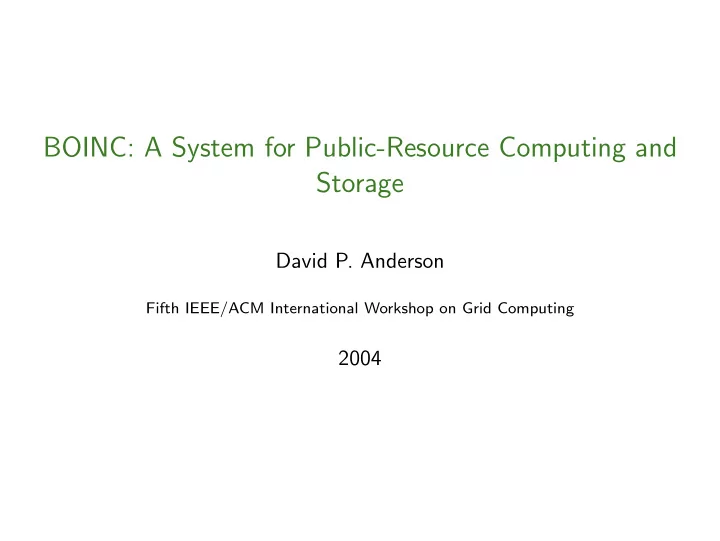

BOINC: A System for Public-Resource Computing and Storage David P. Anderson Fifth IEEE/ACM International Workshop on Grid Computing 2004
Projects Using BOINC Public-Resource Computing Projects Tflops/s 593.650 ◮ SETI@home ◮ Predictor@home - ◮ Folding@home 8.588 ◮ Climate@home - ◮ Einstein@home 288.809 ◮ Climateprediction.net 34.925 ◮ CERN Projects - Xander Wilcke (wex.wilcke@few.vu.nl) Introduction to BOINC February 27, 2012 2 / 17
Overview ◮ What is BOINC? ◮ The Philosophy of BOINC ◮ The Need for BOINC ◮ The Goals of BOINC ◮ The BOINC Architecture ◮ Design Issues and Solutions ◮ Future Development Xander Wilcke (wex.wilcke@few.vu.nl) Introduction to BOINC February 27, 2012 3 / 17
What is BOINC? B erkeley O pen I nfrastructure for N etwork C omputing “. . . a software system that makes it easy for scientists to create and operate public-resource computing projects.” Xander Wilcke (wex.wilcke@few.vu.nl) Introduction to BOINC February 27, 2012 4 / 17
The Philosophy of BOINC BOINC is build upon the Public-resource paradigm Definition Public-resource paradigm: utilize computational resources of personal computers and game consoles. The past decade we have seen the following developments: ◮ Migration of computational resources towards home users. ◮ Computational Power ◮ Storage ◮ Rapid growth of internet penetration Xander Wilcke (wex.wilcke@few.vu.nl) Introduction to BOINC February 27, 2012 5 / 17
The Need for BOINC However, Relatively few large-scale public-resources projects have emerged This is mainly due to the lack of appropriate middleware: ◮ Client and Server Software ◮ Management Tools ◮ User-centered Web Features ◮ . . . Xander Wilcke (wex.wilcke@few.vu.nl) Introduction to BOINC February 27, 2012 6 / 17
The Goals of BOINC “BOINC’s general goal is to advance the public-resource computing paradigm. . . ” Specific goals include: ◮ Reducing the barriers of entry to public-resource computing ◮ Sharing resources among autonomous projects ◮ Supporting diverse applications ◮ Rewarding participants Xander Wilcke (wex.wilcke@few.vu.nl) Introduction to BOINC February 27, 2012 7 / 17
The BOINC Architecture Xander Wilcke (wex.wilcke@few.vu.nl) Introduction to BOINC February 27, 2012 8 / 17
Design Issues ◮ Redundant Computing ◮ Handle Heterogeneous Environments ◮ Local Scheduling ◮ Participant Preferences ◮ Credit and Accounting ◮ User Community Features We will look at these in more detail. Xander Wilcke (wex.wilcke@few.vu.nl) Introduction to BOINC February 27, 2012 9 / 17
Design: Redundant Computing A project can specify that N results should be created for each task. Once M ≤ N of these have been distributed and completed, a comparison is made and a canonical result is formed. The following server daemon processes take care of this: ◮ the transitioner Generates new results and identifies errors ◮ the validator Compares results and creates canonical result ◮ the assimilator Insert canonical results into scientific database ◮ the deleter Delete obsolete input and output files Xander Wilcke (wex.wilcke@few.vu.nl) Introduction to BOINC February 27, 2012 10 / 17
Design: Handle Heterogeneous Environments BOINC provides a flexible framework for distributing application executables. Linux, Mac and Windows are supported by default. However, participants are also able to compile the application themselves. These applications will be seen as running on an ‘anonymous’ platform. Xander Wilcke (wex.wilcke@few.vu.nl) Introduction to BOINC February 27, 2012 11 / 17
Design: Local Scheduling BOINC implements a local scheduling policy. The goals of this policy are . . . ◮ to maximize resource usage, ◮ to satisfy result deadlines, ◮ to respect resource sharing allocation among projects, and ◮ to maintain variety among projects. Xander Wilcke (wex.wilcke@few.vu.nl) Introduction to BOINC February 27, 2012 12 / 17
Design: Participant Preferences Participants want no significant inconvenience, costs or risk. Therefore, BOINC lets participants control how and when their resources are used: Participants can . . . ◮ specify the limits of work buffering, ◮ whether BOINC may work when the machine is not idle, ◮ during what hours BOINC may work, ◮ how many disk space BOINC may use, ◮ how much network bandwidth BOINC may use, and more. Xander Wilcke (wex.wilcke@few.vu.nl) Introduction to BOINC February 27, 2012 13 / 17
Design: Credit and Accounting Participants need incentives in order to stay interested. Therefore, credits are attributed to an account. The amount depends on elapsed CPU/GPU time. BOINC can provide user statistics as XML files which can then be posted by third parties. BOINC allows for cross-project identification, so that one account can participate in multiple projects. The gained credit is then summed. Xander Wilcke (wex.wilcke@few.vu.nl) Introduction to BOINC February 27, 2012 14 / 17
Design: User Community Features BOINC provides participant-oriented web features, such as: ◮ The ability to form teams. ◮ The ability to create and browse user profiles, including text and images. ◮ A message board. ◮ A credit reputation system. Xander Wilcke (wex.wilcke@few.vu.nl) Introduction to BOINC February 27, 2012 15 / 17
Future Development Many areas of the BOINC design are incomplete. For example: ◮ No broadcast method is available yet. ◮ Scarce-resource situations are yet to be resolved. ◮ Multiple storage disks are not yet supported. Xander Wilcke (wex.wilcke@few.vu.nl) Introduction to BOINC February 27, 2012 16 / 17
Conclusion To conclude, BOINC is a promising approach towards distributed computing by offering easy public-resource computing. It provides many novel and useful features, both for participants and scientists. Join a project, contribute to science: “boinc-wiki.info” ‘‘http://boinc.berkeley.edu/’’ A Powered by L T EX Xander Wilcke (wex.wilcke@few.vu.nl) Introduction to BOINC February 27, 2012 17 / 17
Recommend
More recommend